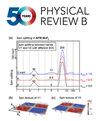Spin transport through a nanojunction with a precessing anisotropic molecular spin: Quantum interference and spin-transfer torque
IF 3.7
2区 物理与天体物理
Q1 Physics and Astronomy
引用次数: 0
Abstract
The subject of this study is spin transport through a molecular orbital connected to two leads, and coupled via exchange interaction with a precessing anisotropic molecular spin in a constant magnetic field. The inelastic spin-flip processes between molecular quasienergy levels are driven by the molecular spin precession. By setting the Larmor frequency, the tilt angle of molecular magnetization with respect to the magnetic field, and the magnetic anisotropy parameter, one can modulate the spin current and noise, spin-transfer torque, and related torque coefficients. Moreover, the dc-spin current and spin-transfer torque components provide the quasienergy level structure in the orbital. Quantum interference effects between states connected with spin-flip processes manifest themselves as dips (minimums) and peaks (maximums) in spin-current noise, matching Fano-like resonance profiles with equal probabilities of interfering elastic and inelastic spin-flip pathways. By proper adjustment of the anisotropy parameter and magnetic field, the precession is suppressed and the torque vanishes, revealing the anisotropy parameter via a dc-spin current or torque measurement. The results of the study show that spin transport and spin-transfer torque can be manipulated by the anisotropy parameter even in the absence of the magnetic field.具有进动各向异性分子自旋的纳米结的自旋输运:量子干涉和自旋转移扭矩
本研究的主题是通过连接到两个引线的分子轨道,并在恒定磁场中通过交换相互作用与进动各向异性分子自旋耦合的自旋输运。分子准能级间的非弹性自旋翻转过程由分子自旋进动驱动。通过设置Larmor频率、分子磁化相对于磁场的倾斜角和磁各向异性参数,可以调节自旋电流和噪声、自旋传递转矩以及相关转矩系数。此外,直流自旋电流和自旋传递转矩分量提供了轨道中的准能级结构。与自旋翻转过程相关的状态之间的量子干涉效应表现为自旋电流噪声的低谷(最小值)和峰值(最大值),匹配具有相同概率的干扰弹性和非弹性自旋翻转路径的类法诺共振谱。通过适当调整各向异性参数和磁场,可以抑制进动,消除转矩,通过直流自旋电流或转矩测量显示各向异性参数。研究结果表明,即使在没有磁场的情况下,各向异性参数也可以控制自旋输运和自旋传递扭矩。
本文章由计算机程序翻译,如有差异,请以英文原文为准。
求助全文
约1分钟内获得全文
求助全文
来源期刊

Physical Review B
物理-物理:凝聚态物理
CiteScore
6.70
自引率
32.40%
发文量
0
审稿时长
3.0 months
期刊介绍:
Physical Review B (PRB) is the world’s largest dedicated physics journal, publishing approximately 100 new, high-quality papers each week. The most highly cited journal in condensed matter physics, PRB provides outstanding depth and breadth of coverage, combined with unrivaled context and background for ongoing research by scientists worldwide.
PRB covers the full range of condensed matter, materials physics, and related subfields, including:
-Structure and phase transitions
-Ferroelectrics and multiferroics
-Disordered systems and alloys
-Magnetism
-Superconductivity
-Electronic structure, photonics, and metamaterials
-Semiconductors and mesoscopic systems
-Surfaces, nanoscience, and two-dimensional materials
-Topological states of matter
 求助内容:
求助内容: 应助结果提醒方式:
应助结果提醒方式:


